While here at CNET we recommend that you purchase the biggest TV that fits in your room, the 55-inch television is still a sweet spot due to its combination of size and affordability.
Most modern 55-inch televisions come with plenty of features and are smart, so you can enjoy streaming your favorite shows and films on Amazon Prime Video, Hulu, Netflix, Disney Plus and more. And higher-end examples offer all the bells and whistles we’ve come to expect, including full-array local dimming, OLED screens, 120Hz refresh rate, 4K UHD resolution, high dynamic range, a plethora of HDMI ports, and even high-end gaming features — including variable refresh rate — to go with a PlayStation 5 or Xbox Series X.
The list below represents our favorite 55-inch TVs right now, and even in summer of 2022, our best TV advice is still to buy a 2021 model (Some of which are in the picks below). We update this list periodically and if we haven’t reviewed the newest version yet, we include a “2022 Outlook” section to give you a sense of what you’re missing.
Read more: Do This to Your TV Now: 9 Crucial Settings to Improve the Picture


Sarah Tew/CNET
TCL 55R635
Best 55-inch TV for the money
No TV we’ve ever tested offers this much picture quality for as little cash. The TCL 6-Series Dolby Vision HDR TV has an excellent image thanks to mini-LED tech and well-implemented full-array local dimming that helps it run circles around just about any other TV at this price. It’s also a solid choice for gamers, with a THX mode that combines low input lag and high contrast. As if that’s not enough, the Roku TV operating system is our hands-down favorite.
This TV first came out in 2020 but is still a current model and remains our top choice. TCL also sells an 8K version of the 6-Series, but we don’t think it’s worth the extra money, as well as a Google-powered version we have yet to review (although according to TCL its image quality is the same as this Roku version).
2022 outlook: TCL has yet to announce a successor for this TV. We’re betting it will do so later this summer.

 \n ","topic":"TVs","ttag":"cxity","searchDim":"article-body|listicle|image","variant":"article-body|listicle|image","viewguid":"","event":"listicle|image|2","correlationId":"","assettitle":"","campaign":"cxity","cval":68,"leadCpc":0.68,"leadProdPrice":1096.99,"manufacturer":"LG","productName":"LG OLED55C1PUB","seriesGuid":"317077fd-582b-4411-bf7c-dfbe9ca7a90f","sku":"\u200eE99LGOLED55C1PUB","reviewId":"0e48ae79-2106-416a-9448-efb2da83a526","formatType":"IMAGE","location":"LIST","position":2,"dwLinkTag":"article-body|listicle|image","selector":"#article-body #listicle-3a1c0d70-a043-4b28-832e-b0e1b833c251 .itemImage"}}” rel=”noopener nofollow” target=”_blank”>
\n ","topic":"TVs","ttag":"cxity","searchDim":"article-body|listicle|image","variant":"article-body|listicle|image","viewguid":"","event":"listicle|image|2","correlationId":"","assettitle":"","campaign":"cxity","cval":68,"leadCpc":0.68,"leadProdPrice":1096.99,"manufacturer":"LG","productName":"LG OLED55C1PUB","seriesGuid":"317077fd-582b-4411-bf7c-dfbe9ca7a90f","sku":"\u200eE99LGOLED55C1PUB","reviewId":"0e48ae79-2106-416a-9448-efb2da83a526","formatType":"IMAGE","location":"LIST","position":2,"dwLinkTag":"article-body|listicle|image","selector":"#article-body #listicle-3a1c0d70-a043-4b28-832e-b0e1b833c251 .itemImage"}}” rel=”noopener nofollow” target=”_blank”>
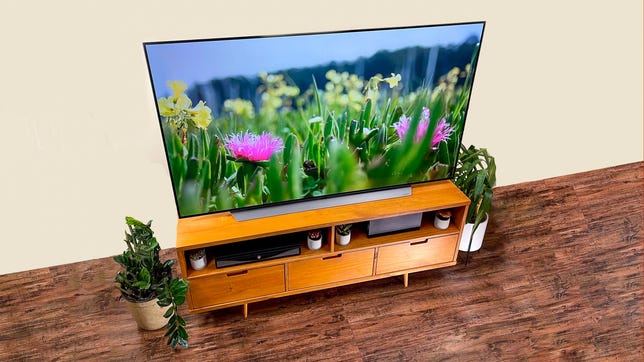

David Katzmaier/CNET
With picture quality as good as any TV we’ve ever tested and a price that’s not too crazy, the LG C1 OLED TV is still our go-to pick for people who prioritize picture and are willing to pay for it. It beats any non-OLED TV on this list, including the Samsung QN90A below, with its perfect black levels, unbeatable contrast and superb off-angle viewing. It also has the best gaming features, making it the perfect companion to an Xbox Series X or S, PlayStation 5 or both.
We also reviewed the successor to the C1, the LG C2, and the two have essentially identical picture quality. The newer version brings a couple of minor improvements, including lighter weight and a couple new gaming modes. Since the 2021 C1 currently remains on sale for hundreds less than the 2022 C2, we recommend getting the C1 instead.

 \n ","topic":"TVs","ttag":"other","searchDim":"article-body|listicle|image","variant":"article-body|listicle|image","viewguid":"","event":"listicle|image|3","correlationId":"","assettitle":"","campaign":"other","cval":35,"leadCpc":0.35,"leadProdPrice":339.99,"manufacturer":"TCL","productName":"TCL 55S435","seriesGuid":"fde5de93-2f82-4e65-8933-21b8a029f509","sku":"55S435","reviewId":"6fcf15b1-15e9-45ce-a078-d1924afef918","formatType":"IMAGE","location":"LIST","position":3,"dwLinkTag":"article-body|listicle|image","selector":"#article-body #listicle-a1fef67c-e2be-45b7-a213-3df6b4e30e0b .itemImage"}}” rel=”noopener nofollow” target=”_blank”>
\n ","topic":"TVs","ttag":"other","searchDim":"article-body|listicle|image","variant":"article-body|listicle|image","viewguid":"","event":"listicle|image|3","correlationId":"","assettitle":"","campaign":"other","cval":35,"leadCpc":0.35,"leadProdPrice":339.99,"manufacturer":"TCL","productName":"TCL 55S435","seriesGuid":"fde5de93-2f82-4e65-8933-21b8a029f509","sku":"55S435","reviewId":"6fcf15b1-15e9-45ce-a078-d1924afef918","formatType":"IMAGE","location":"LIST","position":3,"dwLinkTag":"article-body|listicle|image","selector":"#article-body #listicle-a1fef67c-e2be-45b7-a213-3df6b4e30e0b .itemImage"}}” rel=”noopener nofollow” target=”_blank”>


Sarah Tew/CNET
Roku is our favorite platform for live TV streaming services like Netflix, Hulu and Amazon Prime Video, and it’s even better baked into the TV. This TCL 4-Series can’t beat any of the models above on image quality — its 4K resolution and HDR performance don’t do much to help the picture — but it’s perfectly fine for most people, especially at this price.
Note that TCL also makes a Google TV and an Android TV version of the 4-Series. We haven’t reviewed them, but we expect similar picture quality to the Roku version.
2022 outlook: TCL has yet to announce a successor for this TV.

 \n ","topic":"TVs","ttag":"amazon","searchDim":"article-body|listicle|image","variant":"article-body|listicle|image","viewguid":"","event":"listicle|image|4","correlationId":"","assettitle":"","campaign":"amazon","cval":36,"leadCpc":0.36,"leadProdPrice":549,"manufacturer":"Vizio","productName":"Vizio M55Q7-J01 M-Series Quantum","seriesGuid":"ed9156cd-cbc4-4a61-9642-c0995ea61d11","sku":"M55Q7-J01","reviewId":"fb539115-8091-439d-8681-5e2e6876779b","formatType":"IMAGE","location":"LIST","position":4,"dwLinkTag":"article-body|listicle|image","selector":"#article-body #listicle-890f9887-bece-426b-b3f0-149ee179fe3c .itemImage"}}” rel=”noopener nofollow” target=”_blank”>
\n ","topic":"TVs","ttag":"amazon","searchDim":"article-body|listicle|image","variant":"article-body|listicle|image","viewguid":"","event":"listicle|image|4","correlationId":"","assettitle":"","campaign":"amazon","cval":36,"leadCpc":0.36,"leadProdPrice":549,"manufacturer":"Vizio","productName":"Vizio M55Q7-J01 M-Series Quantum","seriesGuid":"ed9156cd-cbc4-4a61-9642-c0995ea61d11","sku":"M55Q7-J01","reviewId":"fb539115-8091-439d-8681-5e2e6876779b","formatType":"IMAGE","location":"LIST","position":4,"dwLinkTag":"article-body|listicle|image","selector":"#article-body #listicle-890f9887-bece-426b-b3f0-149ee179fe3c .itemImage"}}” rel=”noopener nofollow” target=”_blank”>


David Katzmaier/CNET
The TVs above are amazing, but what if you can’t afford that level of picture quality? The Vizio MQ7 is one of the least expensive TVs to feature full-array local dimming, which lets it reproduce TV shows, movies and games with enough contrast and pop to do HDR justice. It’s a 60Hz model, not 120Hz, but it still handles variable refresh rate games for extra smoothness. If you can’t save up for the TCL 6-series, the Vizio MQ7 makes an excellent consolation prize.
2022 outlook: Vizio has yet to announce a successor for this TV.

 \n ","topic":"TVs","ttag":"amazon","searchDim":"article-body|listicle|image","variant":"article-body|listicle|image","viewguid":"","event":"listicle|image|5","correlationId":"","assettitle":"","campaign":"amazon","cval":36,"leadCpc":0.36,"leadProdPrice":399.99,"manufacturer":"Vizio","productName":"Vizio V555-J","seriesGuid":"76a9d689-9e2f-4443-a7bb-d4a0c84114e1","sku":"V555-J01","reviewId":"122585e4-b4be-4da8-9afc-6cb935664fc2","formatType":"IMAGE","location":"LIST","position":5,"dwLinkTag":"article-body|listicle|image","selector":"#article-body #listicle-895629da-b7c9-416c-9b57-66c1b769c19f .itemImage"}}” rel=”noopener nofollow” target=”_blank”>
\n ","topic":"TVs","ttag":"amazon","searchDim":"article-body|listicle|image","variant":"article-body|listicle|image","viewguid":"","event":"listicle|image|5","correlationId":"","assettitle":"","campaign":"amazon","cval":36,"leadCpc":0.36,"leadProdPrice":399.99,"manufacturer":"Vizio","productName":"Vizio V555-J","seriesGuid":"76a9d689-9e2f-4443-a7bb-d4a0c84114e1","sku":"V555-J01","reviewId":"122585e4-b4be-4da8-9afc-6cb935664fc2","formatType":"IMAGE","location":"LIST","position":5,"dwLinkTag":"article-body|listicle|image","selector":"#article-body #listicle-895629da-b7c9-416c-9b57-66c1b769c19f .itemImage"}}” rel=”noopener nofollow” target=”_blank”>
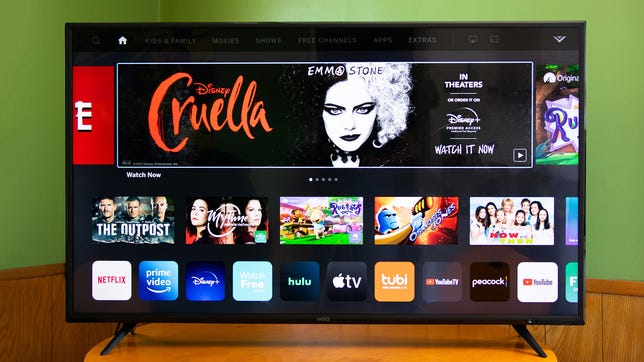

Geoffrey Morrison/CNET
Vizio’s V-series is our favorite budget alternative to the TCL 4-Series Roku TV. We liked Roku’s smart TV system better (sound familiar?), but the V-series has some advantages, including a better remote with voice and more advanced picture settings. Picture quality between the two was basically the same, so if you don’t have a preference, it makes sense to get the cheapest one.
2022 outlook: Vizio has yet to announce a successor for this TV.

 \n ","topic":"TVs","ttag":"other","searchDim":"article-body|listicle|image","variant":"article-body|listicle|image","viewguid":"","event":"listicle|image|6","correlationId":"","assettitle":"","campaign":"other","cval":40,"leadCpc":0.4,"leadProdPrice":1999.99,"manufacturer":"LG","productName":"LG OLED55C2PUA","seriesGuid":"1388797e-7d7a-4421-969f-96575f998133","sku":"OLED55C2PUA","reviewId":"","formatType":"IMAGE","location":"LIST","position":6,"dwLinkTag":"article-body|listicle|image","selector":"#article-body #listicle-d58d8ef3-f9d4-4c75-8d23-3d261db02ccc .itemImage"}}” rel=”noopener nofollow” target=”_blank”>
\n ","topic":"TVs","ttag":"other","searchDim":"article-body|listicle|image","variant":"article-body|listicle|image","viewguid":"","event":"listicle|image|6","correlationId":"","assettitle":"","campaign":"other","cval":40,"leadCpc":0.4,"leadProdPrice":1999.99,"manufacturer":"LG","productName":"LG OLED55C2PUA","seriesGuid":"1388797e-7d7a-4421-969f-96575f998133","sku":"OLED55C2PUA","reviewId":"","formatType":"IMAGE","location":"LIST","position":6,"dwLinkTag":"article-body|listicle|image","selector":"#article-body #listicle-d58d8ef3-f9d4-4c75-8d23-3d261db02ccc .itemImage"}}” rel=”noopener nofollow” target=”_blank”>
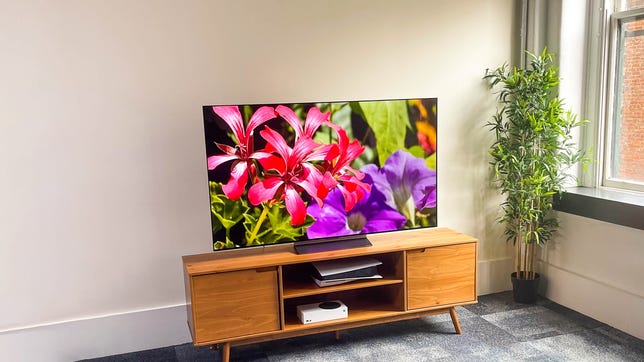

David Katzmaier/CNET
The C2 is the first 2022 TV we’ve reviewed and it’s superb, but right now the 2021 model is a better deal. We compared the C2 directly with last year’s C1, side by side. In terms of picture quality, the two were basically identical, despite the fact that LG touts the new “Evo” panel on the C2. Real improvements include carbon-fiber construction for lighter weight — the 55-inch version weighs just 32 pounds with its stand, versus 51 pounds for the 55-inch C1 — as well as some additional tweaks to game mode and a new “always on” feature. Those enhancements aren’t worth the price difference, so our advice is to buy a C1 now or wait until later this year, when the C1 sells out and the C2 gets a price cut.

 \n ","topic":"TVs","ttag":"amazon","searchDim":"article-body|listicle|image","variant":"article-body|listicle|image","viewguid":"","event":"listicle|image|7","correlationId":"","assettitle":"","campaign":"amazon","cval":36,"leadCpc":0.36,"leadProdPrice":2199,"manufacturer":"Samsung","productName":"Samsung QN55QN90A","seriesGuid":"96d557a1-660d-44d3-a6a0-a4cf824896f3","sku":"QN55QN90AAFXZA","reviewId":"5fa4c134-a502-460d-ac07-72a58a469039","formatType":"IMAGE","location":"LIST","position":7,"dwLinkTag":"article-body|listicle|image","selector":"#article-body #listicle-fae771f5-f271-40a8-a9a2-92e995fb70f4 .itemImage"}}” rel=”noopener nofollow” target=”_blank”>
\n ","topic":"TVs","ttag":"amazon","searchDim":"article-body|listicle|image","variant":"article-body|listicle|image","viewguid":"","event":"listicle|image|7","correlationId":"","assettitle":"","campaign":"amazon","cval":36,"leadCpc":0.36,"leadProdPrice":2199,"manufacturer":"Samsung","productName":"Samsung QN55QN90A","seriesGuid":"96d557a1-660d-44d3-a6a0-a4cf824896f3","sku":"QN55QN90AAFXZA","reviewId":"5fa4c134-a502-460d-ac07-72a58a469039","formatType":"IMAGE","location":"LIST","position":7,"dwLinkTag":"article-body|listicle|image","selector":"#article-body #listicle-fae771f5-f271-40a8-a9a2-92e995fb70f4 .itemImage"}}” rel=”noopener nofollow” target=”_blank”>
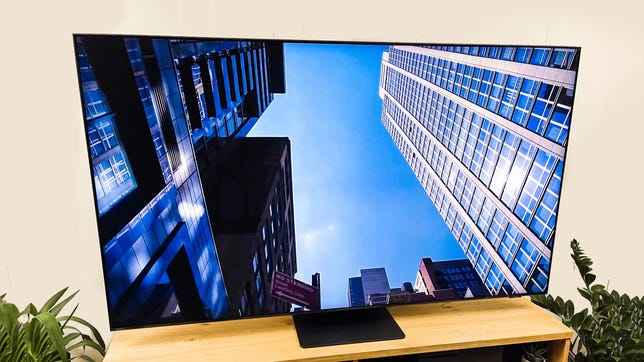

David Katzmaier/CNET
Looking for a high-end TV with spectacular image quality, but don’t want an OLED? The Samsung QN90A is your best bet. This TV uses QLED TV tech augmented by mini-LED for a brighter image than any OLED TV. The spectacular contrast of OLED still won out in my side-by-side tests, but the QN90A QLED screen comes closer than ever.
2022 outlook: The 2022 version of the Samsung QN90A is called the QN90B. We haven’t reviewed it yet, but we expect it to have very similar image quality. Samsung touts improved processing and a few extra features but nothing earth-shattering, and the 2022 QN90B currently costs hundreds of dollars more than the 2021 QN90A.


David Katzmaier/CNET
Sony XR55X90J
Best mid-priced 55-inch alternative to TCL, Vizio
With excellent picture quality, anchored by full-array local dimming and plenty of brightness to make HDR content shine, the X90J is Sony’s answer to the TCL 6-Series and step-up Vizio models. This LED TV’s sleek looks and the Google TV operating system score additional points, as does its next-gen console support — including variable refresh rate (VRR), enabled by a software update in March 2022 — and built-in NextGen TV tuner. This Sony TV is perfect for PS5 gaming and works with Alexa & Google Assistant. If you want an “S” brand, this is one of the best values we’ve tested.
2022 outlook: The successor to the X90J is the X90K. We haven’t reviewed the new model yet but its image quality specifications are largely similar to the 2021 version, so we don’t expect many picture quality differences. Unlike the 2021 version, the new model ships with VRR enabled out of the box.

 \n ","topic":"TVs","ttag":"other","searchDim":"article-body|listicle|image","variant":"article-body|listicle|image","viewguid":"","event":"listicle|image|9","correlationId":"","assettitle":"","campaign":"other","cval":40,"leadCpc":0.4,"leadProdPrice":749.99,"manufacturer":"Samsung","productName":"Samsung Q60B Series (2022, 55-inch)","seriesGuid":"4792ec9d-3807-48e1-a50d-c53d59427edb","sku":"QN55Q60BAFXZA","reviewId":"","formatType":"IMAGE","location":"LIST","position":9,"dwLinkTag":"article-body|listicle|image","selector":"#article-body #listicle-671865a2-2277-4df1-8d76-3365e03d6097 .itemImage"}}” rel=”noopener nofollow” target=”_blank”>
\n ","topic":"TVs","ttag":"other","searchDim":"article-body|listicle|image","variant":"article-body|listicle|image","viewguid":"","event":"listicle|image|9","correlationId":"","assettitle":"","campaign":"other","cval":40,"leadCpc":0.4,"leadProdPrice":749.99,"manufacturer":"Samsung","productName":"Samsung Q60B Series (2022, 55-inch)","seriesGuid":"4792ec9d-3807-48e1-a50d-c53d59427edb","sku":"QN55Q60BAFXZA","reviewId":"","formatType":"IMAGE","location":"LIST","position":9,"dwLinkTag":"article-body|listicle|image","selector":"#article-body #listicle-671865a2-2277-4df1-8d76-3365e03d6097 .itemImage"}}” rel=”noopener nofollow” target=”_blank”>
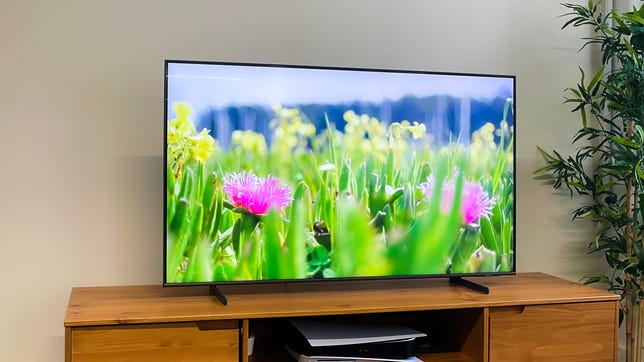

James Martin/CNET
Samsung is the brand that sells more TVs than anyone, and one of its most popular is the Q60 series. Its sleek QLED screen design stands out compared with the other TVs on this list — even though the ultrathin OLED models are sleeker — and it offers better features, image quality and more sizes than models like the TCL 4-Series and Sony X80K. The TVs listed in this article are all superior values, but if you want a Samsung TV and can’t afford the QN90A, this is a great choice.
Note that the 2021 version, the Q60A, is still on sale and can be cheaper than the Q60B. The newer version measured brighter in our tests, but if you want the best deal, stick with the Q60A if it’s still available.

 \n ","topic":"","ttag":"","searchDim":"article-body|listicle|image","variant":"article-body|listicle|image","viewguid":"","event":"listicle|image|10","correlationId":"","_destCat":"https:\/\/www.amazon.com\/dp\/B091YJQGVW\/ref=asc_df_B091YJQGVW1638702000000?tag=cnet-ce-20&creative=395261&creativeASIN=B091YJQGVW&linkCode=asn&ascsubtag=db09caf20086491a94178493854c473d%7C___VIEW_GUID___%7Cdtp","productName":"Hisense 55U8G","formatType":"IMAGE","location":"LIST","position":10,"sku":"55U8G","dwLinkTag":"article-body|listicle|image","selector":"#article-body #listicle-2de52903-3085-4625-8e31-bb047a91a151 .itemImage"}}” rel=”noopener nofollow” target=”_blank”>
\n ","topic":"","ttag":"","searchDim":"article-body|listicle|image","variant":"article-body|listicle|image","viewguid":"","event":"listicle|image|10","correlationId":"","_destCat":"https:\/\/www.amazon.com\/dp\/B091YJQGVW\/ref=asc_df_B091YJQGVW1638702000000?tag=cnet-ce-20&creative=395261&creativeASIN=B091YJQGVW&linkCode=asn&ascsubtag=db09caf20086491a94178493854c473d%7C___VIEW_GUID___%7Cdtp","productName":"Hisense 55U8G","formatType":"IMAGE","location":"LIST","position":10,"sku":"55U8G","dwLinkTag":"article-body|listicle|image","selector":"#article-body #listicle-2de52903-3085-4625-8e31-bb047a91a151 .itemImage"}}” rel=”noopener nofollow” target=”_blank”>
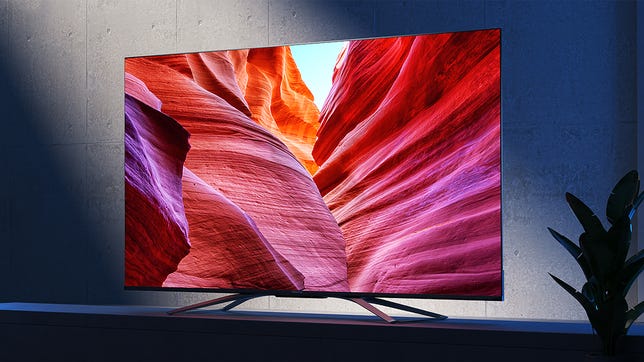

David Katzmaier/CNET
Most of the TVs on this list are bright enough for just about any room, but maybe you want a screen that’s as bright as possible. The U8G outshines others in its price range and was basically as bright as the significantly more expensive Samsung QN90A. Its image quality falls a bit short in other areas but if raw brightness is what you crave, the U8G delivers.
2022 outlook: The successor to the Hisense U8G is the U8H, shipping later this summer. The new version uses a mini-LED backlight and could improve the image quality of the 2021 model, but we haven’t reviewed it yet so we can’t say for sure. Unlike the 2021 U8G, the 2022 U8H includes an ATSC 3.0 tuner.
Other TVs we’ve tested
Sony KD-X80K series: Sony is a prominent brand and its higher-end TVs like the X90J do well in reviews, but the entry-level TV in its 2022 lineup, the X80K, didn’t make the list. It costs around the same as the TCL 6-Series and Samsung Q60 TVs, and had a worse picture than both, with lighter black levels and contrast. It’s definitely not a bad TV, and we liked its Google smart TV system, color accuracy and connectivity, but you can definitely do better for the money. Read our Sony KD-X80K series review.
Toshiba Amazon Fire TV C350 series: One of many Fire TVs available for sale, this one is typical of the breed: so-so image quality and a smart TV system that lags behind Roku and Google TV. If you’re a big fan of Alexa voice or see this TV at a really low price it might be worthwhile, but otherwise go for the TCL 4-Series. Read our Toshiba Amazon Fire TV C350 series review.
LG OLED G1 series: The G1 is an excellent overall TV, but compared to the C1 and C2, we don’t think it’s worth the extra money. Image quality is basically the same as those two models, so you just end up paying extra for its ultrathin, wall-hugging “gallery” design. On the other hand if that price difference is small enough — sometimes a G1 will cost only $100 more than a C1, for example — it might be worthwhile for you. Note that this TV’s successor, the 2022 LG G2, promises a brighter picture, but we haven’t reviewed it yet so we can’t say for sure. Read our LG OLED G1 series review.
How does CNET test TVs?
Our TV reviews follow a rigorous, unbiased evaluation process honed over nearly two decades of TV reviews. Our primary TV test lab has specialized equipment for measuring light and color, including a Konica Minolta CS-2000 spectroradiometer, a Murideo Sig-G 4K HDR signal generator and an AVPro Connect 8×8 4K HDR distribution matrix. We Portrait Displays CalMan Ultimate software to evaluate and calibrate every TV we review. In every CNET TV review, three or more similar TVs are compared side-by-side in various lighting conditions with different content, including movies, TV shows and games, across a variety of test categories, from color to video processing to gaming to HDR. Our reviews also account for design, features, smart TV performance, HDMI input and gaming compatibility and more.
Read more: How We Test TVs
55-inch TV FAQs
Is a 55-inch TV big enough?
It depends on your room size, seating distance and personal taste. For a standard master bedroom or smaller living room a 55-inch TV is fine, but for larger rooms we recommend a larger TV, say a 65- or even 75-inch model, if you can afford it. If you sit closer to the screen you don’t need as large a TV for the best experience. For maximum theatrical impact, according to THX and SMPTE, you should be between 5.5 and 7 feet from a 55-inch screen, which is relatively close. Nearly every 55-inch TV has 4K resolution, and if you have 20/20 vision you can sit as close as about 4 feet and still not discern individual pixels.
How wide is a 55-inch TV?
Most 55-inch TVs measure between 48 and 49 inches wide. Because the frames around newer TV screens are typically quite narrow, 55-inch TV widths don’t vary much. Models with very slim frames are on the lower end — the 55-inch LG G1 measures 48.2 inches wide for example, while the slightly thicker-framed 55-inch TCL 4-Series is 48.7 inches wide. If you’re not planning to wall-mount the TV, you generally want the piece of furniture supporting the TV to measure at least as wide as the TV itself, and preferably a few inches wider. Refer to the manufacturer’s website for exact dimensions of a particular 55-inch TV.
How much does a 55-inch TV weigh?
A 55-inch TV weighs between 25 and 50 pounds with its stand, but this varies significantly depending on the type of TV. The TCL 4-Series 55-inch TV weighs 24.9 pounds with stand, for example, while the LG C1 weighs twice as much at 50.7 pounds with stand. Removing the stand — which often consists of a pair of little legs under the panel — allows you to wall-mount the TV and reduces its weight slightly (stands weigh between 1 and 8 pounds). Shipping weight (box, accessories, etc.) of 55-inch TVs ranges from 35 to 63 pounds. Refer to the manufacturer’s website for exact weights of a particular 55-inch TV.
